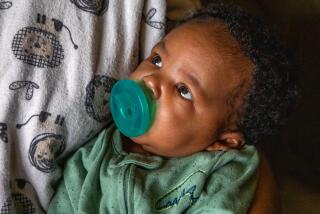Infants’ Skulls May Be Deformed From Lying on Backs for Too Long
- Share via
Jennifer Carroll knew she was part of a national trend when she faithfully put her newborn son, Brennan, to sleep on his back.
What shocked her was that she also had become part of a resulting epidemic.
When Brennan was 2 months old, Carroll, of North Branford, Conn., noticed that the back of his head looked a bit flat. The pediatrician said he would probably grow out of it.
But after four months, Brennan’s head was even more misshapen. And he was far from alone.
Across the country, doctors’ offices have been flooded with infants displaying varying degrees of skull deformity caused by spending too much time on their backs.
The surge in flattened heads began after 1992, when the American Academy of Pediatrics recommended that infants sleep on their backs or sides--not their stomachs--to lower the risk of Sudden Infant Death Syndrome.
The recommendation appears to have saved many lives, with the U.S. SIDS rate down an estimated 40% as a result of the “Back-to-Sleep” campaign.
But spending so much time with their heads flat on a mattress, or in car seats or baby swings, has had an unintended--although not calamitous--downside.
Jeanne Pomatto, who developed the first head-shape correction helmet to be approved by the U.S. Food and Drug Administration, said that about one in every 300 newborns had misshapen heads caused by sleep position before the Back-to-Sleep movement. Now the incidence is one in 60 or 70 worldwide, she said.
She said parents should continue to place their children on their backs for sleeping but should vary their positions when they are awake.
“These are not life-threatening problems, but they are not things that are completely normal,” said Dr. Joseph H. Shin, director of the Yale Craniofacial Center in New Haven, Conn.
Approaches to correcting the head’s flatness range from simply making sure the baby does not sleep for hours in the same position to fitting the child with a helmet-like band, such as Pomatto’s, that prevents further flattening while reshaping the skull.
Shin referred the Carrolls to Cranial Technologies Inc., Pomatto’s company, based in Tempe, Ariz., which opened an office in Clinton last year. The company manufactures individually fitted, 6-ounce hard plastic helmets to correct head deformities caused by sleep position.
Ball said the ideal time to start treatment is before a child reaches 7 months, while the skull is still soft and sutures that will later fuse the plates of the skull are still malleable. By 18 months, children’s skulls are too hard to be reshaped.
Dr. Mark Iantosca, a pediatric neurosurgeon at the Connecticut Children’s Medical Center in Hartford, said he sees four or five new patients a week with flat heads caused by sleeping position. But except for the most severe cases, he takes a conservative approach.
“Generally, it resolves with time,” Iantosca said. As children reach 6 months and begin to spend more time upright, their heads generally become symmetrical.
But even if parents are inclined to let nature and growth take their course, Iantosca urges them to consult a neurosurgeon or plastic surgeon to ensure that head flattening is not caused by a more serious condition called craniosynostosis, in which the plates of the brain fuse too early.
Craniosynostosis is serious and requires surgery.
More to Read
Sign up for Essential California
The most important California stories and recommendations in your inbox every morning.
You may occasionally receive promotional content from the Los Angeles Times.













